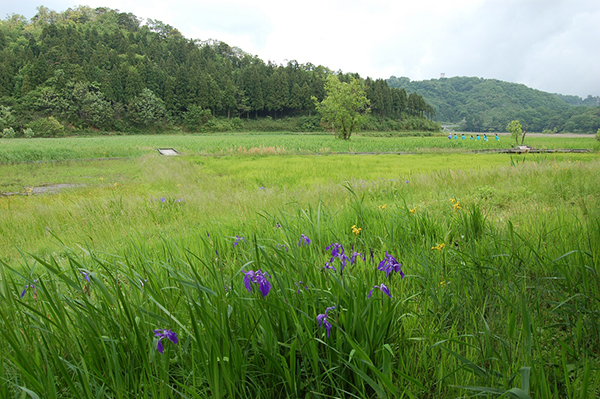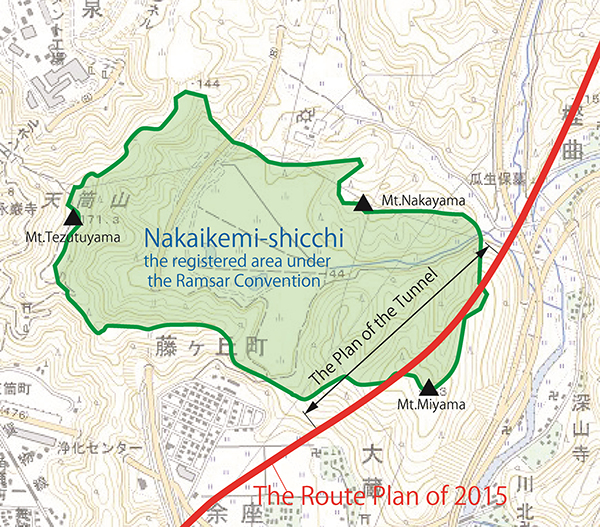A petition to JRTT: Ensuring full compliance with resolutions under Ramsar Convention regarding Hokuriku Bullet Train Railroad plan over Ramsar site, Nakaikemi-shicchi
March 28th 2016
Mr. Takashi Kitamura
Japan Railway Construction, Transport and Technology Agency (JRTT)
Akira Kameyama
Chair of the Board of Directors,
The Nature Conservation Society of Japan
Chieko Sasaki
Chief Director, NPO Wetland Nakaikemi
Masaharu Okamoto, Keiichi Sakaguchi, Yasuo Fujiki
Co-representative Director, NPO Nakikemi Net
Yoshino Ando, Minoru Kashiwagi, Masayuki Kurechi,
Ryoichi Hori, Seiji Maekawa
Co-representatives, Ramsar Network Japan
Atsuo Tsuji, Kumiko Ushino
Co-representative Director Japan Wetland Action Network
Hitoshi Sato
Chair of the Board of Directors,
The Wild Bird Society of Japan
Tsunenari Tokugawa
The President, World Wide Fund for Nature Japan
Nakaikemi Wetland (Tsuruga, Fukui prefecture) is characterized by its world prominent topography called “sac-like waste-filled valley”, consisting of 40 meter deep peat layers accumulated over 100,000 years. It has diverse freshwater environment, providing significant habitats for various fauna and flora. Nakaikemi Wetland was registered as international protected wetland under Ramsar Convention in July 2012.
A railroad construction plan was proposed in the same area. The planned route was released in 1996 and environmental impact statement of this project was submitted in 2002. However, right after the registration of Nakaikemi Wetland as Ramsar site, revised route plan was accepted and released to public, cutting into 150 meters inside the protected area. Later, JRTT held expert committee meetings to discuss possible effects on the site and solutions for risk avoidance and reduction in Nakaikemi Wetland between November 2013 and March 2015. On May 8th 2015, JRTT eventually released the other version of route following the initial plan of 1996.
Because of its peculiar topography, it is assumed that Nakaikemi Wetland has distinctive formation process and self-maintenance system in its peat layers. Present route plan passed through the headwater mountains of the site. Under such situation, it is impossible to foresee potential changes in hydrological system with sufficient accuracy. Once the construction process damages hydrology, it may cause irreversible adverse effects on the formation and system of the whole Nakaikemi Wetland. To make matter worse, the construction within Ramsar sites may give wrong perception to other land development operators, and may lead more development projects in other protected areas both nationally and internationally.
Ramsar Convention aimed to incorporate biodiversity-related issues into environmental impact assessment legislation and/or processes and strategic environmental assessment. Resolution X.17: Environmental Impact Assessment and Strategic Environmental Assessment: Updated Scientific and Technical Guidance was decided by the Parties to the Convention in 2008, and later, it is highly recommended to apply this guidance into any operations within Ramsar wetlands. Highest attention must be paid in the construction over Nakaikemi Wetland area based on these resolutions. We hereby request to your serious consideration and implementation regarding the following actions:
1. To prepare management plan, well-reflected opinions from various specialists including local citizens and NGO’s who have local knowledge in Nakaikemi Wetland.
Environmental impact assessment guideline in Ramsar Convention resolution X.17 requires preparation of ‘environmental management plan’ including detailed information about any actions of reduction, alleviation, and mitigation against possible impacts caused by construction. If its operation goes over Nakaikemi Wetland area, operators shall submit environmental management plan with solid information of constructing methods. For document preparation, make sure to consult with various ecology and construction specialists, and with local citizens and NGOs. Please reflect their opinions into the plan for the purpose of making environmental consideration at highest level.
2. To establish an expert committee having independent verification function, the committee needs to be capable to assess monitoring result and project evaluation regarding environmental consideration.
To ensure planned avoidance or reduction of construction pressures on the site, continuous check and verification function are necessarily needed to normality check for the monitoring results, in the entire process from its proper implementation. Accurate prediction in hydrological change is especially crucial and it is difficult for maintaining Nakaikemi’s water system and its topographical formation. Specialist evaluation is requisite. Please form an expert committee as an independent verifier besides self-verification by operators regarding monitoring and project assessment.
3. To update monitoring results and agenda in expert committee and to make them always available for concerned parties and local community.
Not only is Nakaikemi Wetland considered as world treasure, but local as well. The City of Tsuruga developed an action plan for wetland conservation in May 2015. In their project, the City of Tsuruga carries out monitoring study and promotes conservation and wise use of wetland, including education, tourism, interaction and academic research. Concerned people or parties should be accessible to any information obtained during construction process, and it can be contributed for the wise use of Nakaikem Wetland. Please keep all information available to the public and concerned people, including monitoring result and agenda discussed in the meeting.
4. To formulate emergency plan as a preparation for any contingencies during construction.
Due to the vulnerability of Nakaikemi’s formation and system, a hydrological change can cause irreversible impacts on the site. Therefore intensive ‘emergency plan’ is critical. Emergency plan shall include contact system, correspondence/cooperative system, and immediate actions for unexpected situations, equipment preparation, and training. Any operator who carries out construction over Nakaikemi Wetland must prepare emergency plan prior.
Sincerely yours,


▲Hokuriku Bullet Train Railroad plan


